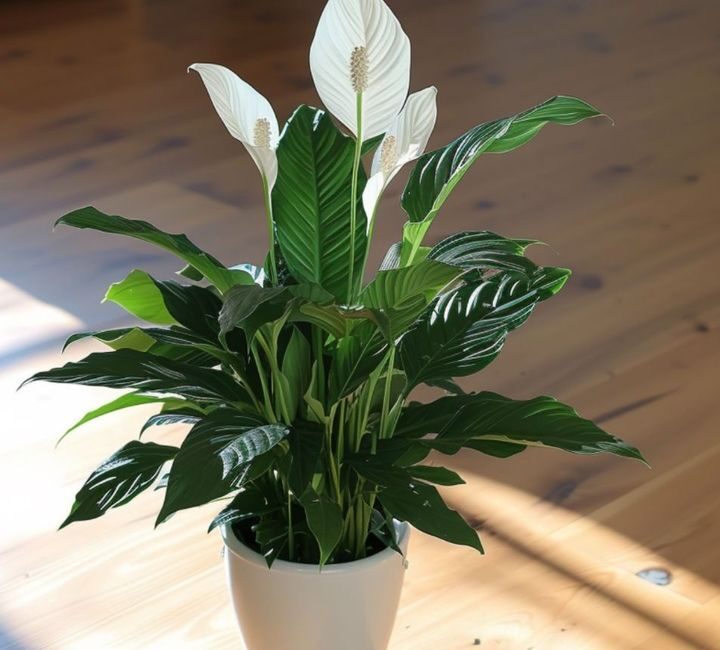Peace lilies (Spathiphyllum spp.) are among the most popular and beloved indoor houseplants, renowned for their elegant, dark green foliage and striking white blooms. Their glossy leaves and elegant white spathes (the modified leaves surrounding the actual flowers) make them an attractive addition to any home or office. However, many people often find that while their peace lilies thrive in terms of lush foliage, they may struggle to get the plant to bloom. If you’ve been wondering how to encourage your peace lily to produce those beautiful white flowers, you’re not alone! Thankfully, there are several ways to coax your peace lily into blooming.
In this article, we’ll explore 11 effective tips and tricks to help you get your peace lily to bloom and keep it healthy and thriving. By adjusting the plant’s environment, care routine, and nutritional needs, you can enjoy a more frequent and abundant display of its signature white blooms.
1. Provide the Right Light Conditions
One of the most important factors that influence whether a peace lily blooms is the light it receives. Peace lilies thrive in moderate to low light, but they do need some indirect sunlight to bloom. If your peace lily is in a location with insufficient light, it may not produce flowers.
What You Should Do:
- Bright, Indirect Light: Place your peace lily in a spot with bright, indirect light, such as near a window with sheer curtains. Direct sunlight can scorch its leaves and hinder blooming.
- Avoid Low-Light Areas: While peace lilies can tolerate low light, they typically won’t bloom without adequate light. If your plant is in a room with no natural light, consider moving it to a brighter location or supplementing with a grow light.
2. Maintain Proper Temperature and Humidity
Peace lilies are native to tropical regions, which means they thrive in warm and humid conditions. The ideal temperature range for peace lilies is between 65°F to 80°F (18°C to 27°C), and they prefer a relatively high level of humidity.
What You Should Do:
- Consistent Temperature: Avoid placing your peace lily near drafts, air conditioners, or heating vents, as extreme temperature fluctuations can stress the plant and prevent blooming.
- Humidity Boost: If you live in a dry climate or your home tends to be dry, especially in winter, increase the humidity around your plant by using a humidifier, placing the plant on a humidity tray filled with pebbles and water, or regularly misting its leaves.
3. Use the Right Potting Soil
The soil you use for your peace lily plays a crucial role in its overall health and blooming potential. Well-draining soil is essential for peace lilies because it ensures proper root aeration and prevents the plant from sitting in water, which can lead to root rot.
What You Should Do:
- Well-Draining Potting Mix: Choose a high-quality potting mix that is lightweight and drains well. You can opt for a general houseplant mix or create your own by combining equal parts of potting soil, perlite, and peat moss.
- Avoid Heavy or Clay-Based Soils: Heavy soils can retain too much moisture and suffocate the roots, preventing the plant from blooming. Make sure the soil doesn’t become compacted.
4. Water the Plant Correctly
Overwatering and underwatering are common problems with peace lilies, and both can interfere with the plant’s ability to bloom. Peace lilies like to be kept moist, but not soggy.
What You Should Do:
- Water When Top Soil is Dry: Water your peace lily when the top 1-2 inches (2.5-5 cm) of soil feel dry to the touch. Make sure the water drains freely from the pot to prevent waterlogging.
- Use Room-Temperature Water: Avoid using cold water, as it can shock the roots. Instead, use room-temperature water, ideally with low mineral content, as peace lilies can be sensitive to chemicals in tap water like chlorine and fluoride.
5. Feed Your Peace Lily with Balanced Fertilizer
Nutrient deficiencies can prevent a peace lily from flowering, so it’s important to feed the plant with a balanced fertilizer. Regular feeding helps the plant to grow healthy and strong, making it more likely to bloom.
What You Should Do:
- Use a Balanced Liquid Fertilizer: Use a balanced liquid fertilizer with an equal ratio of nitrogen (N), phosphorus (P), and potassium (K), such as a 20-20-20 formula. This provides all the nutrients your plant needs for healthy growth and blooming.
- Feed During Growing Season: Fertilize your peace lily every 4-6 weeks during the growing season (spring and summer). Reduce or stop fertilizing during the dormant winter months.
6. Repot When Necessary
Peace lilies are known to become root-bound in their pots, which means their roots have outgrown the container and are crowded. When this happens, the plant may stop flowering because it doesn’t have enough space to grow.
What You Should Do:
- Repot Every 1-2 Years: If your peace lily has outgrown its pot or if the roots are starting to crowd the plant, it’s time to repot. Choose a container that is 1-2 inches (2.5-5 cm) larger in diameter than the current pot.
- Avoid Oversized Pots: Avoid using a pot that is too large, as the plant might focus on root growth instead of blooming.
7. Prune Old Leaves and Spent Blooms
Pruning is an essential task that helps keep your peace lily healthy and encourages new blooms. Removing dead or yellowing leaves and spent flowers not only improves the plant’s appearance but also prevents the spread of disease.
What You Should Do:
- Trim Dead or Damaged Leaves: Regularly cut back any yellow or brown leaves, as these can drain energy from the plant and affect blooming.
- Remove Spent Blooms: As soon as the white flowers (spathes) fade, trim them off at the base of the stem. This will prevent the plant from wasting energy on the old blooms, allowing it to direct its resources toward producing new ones.
8. Ensure Proper Air Circulation
Peace lilies, like all plants, benefit from good airflow. Stagnant air can lead to the growth of mold, mildew, and fungal diseases, all of which can harm the plant and interfere with blooming.
What You Should Do:
- Place in an Area with Good Airflow: Avoid placing your peace lily in a corner where air doesn’t circulate well. A spot with moderate airflow will keep the plant healthy and reduce the risk of diseases.
- Avoid Drafts: While good airflow is necessary, it’s important to avoid placing the peace lily in direct drafts from air conditioners or heating vents, as this can stress the plant.
9. Give It a Rest Period
Like many houseplants, peace lilies go through a period of dormancy during the winter months. During this time, they may not bloom, but they are still resting and recharging for the next growing season.
What You Should Do:
- Reduce Watering and Fertilizing in Winter: During the winter months, reduce the amount of water and fertilizer you provide to your peace lily. This encourages the plant to rest and conserve energy.
- Keep It in a Cooler Spot: If possible, place your peace lily in a slightly cooler area (around 60-65°F or 15-18°C) during the winter. This signals the plant that it’s time to rest and can encourage blooming when the temperatures warm up again.
10. Encourage Blooms with Patience
Sometimes, the key to getting your peace lily to bloom is simply being patient. Peace lilies may not bloom every season, and it’s important to understand that they have natural flowering cycles that may be slower at times.
What You Should Do:
- Allow the Plant Time to Adjust: If you’ve recently moved your peace lily, it may take time for the plant to adjust to its new environment and begin blooming again.
- Be Patient with New Plants: If you’ve recently purchased a peace lily, it may take a few months to bloom as it acclimates to your home.
11. Consider Flowering Time of Year
Peace lilies typically bloom in late spring or early summer, so if your plant is not blooming during this time, there may be a variety of reasons contributing to the lack of flowers.
What You Should Do:
- Provide Ideal Conditions in Spring and Summer: During the growing season, ensure that your peace lily receives the best possible care, including proper light, temperature, watering, and feeding, to encourage blooms.
- Don’t Worry About Off-Season Blooms: While some peace lilies bloom off-season, they are most likely to bloom in the spring and summer months. If you’re not seeing flowers outside of this period, it’s perfectly normal.
Conclusion
Getting your peace lily to bloom can be a rewarding experience, and it’s achievable with the right care and attention to detail. By ensuring it receives the proper light, temperature, humidity, and nutrients, along with regular pruning and occasional repotting, you can encourage your peace lily to produce its beautiful white flowers.
Remember, patience is key—peace lilies have their own natural cycles, and with time and the right environment, your plant will bloom beautifully. So, follow these 11 tips to create an optimal environment for your peace lily, and you’ll soon enjoy the lovely blooms that make this plant such a popular and cherished addition to any home.




